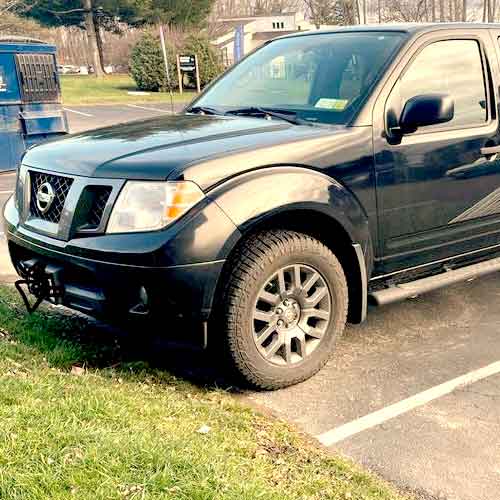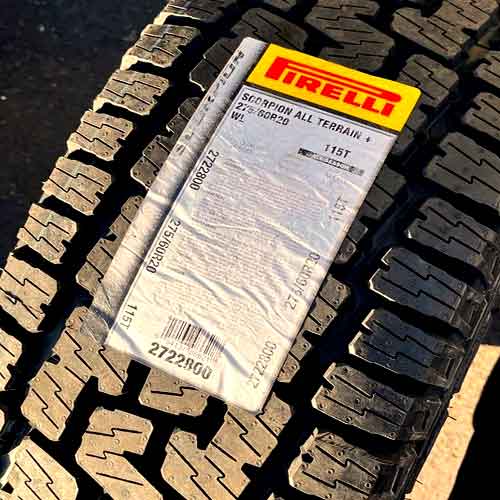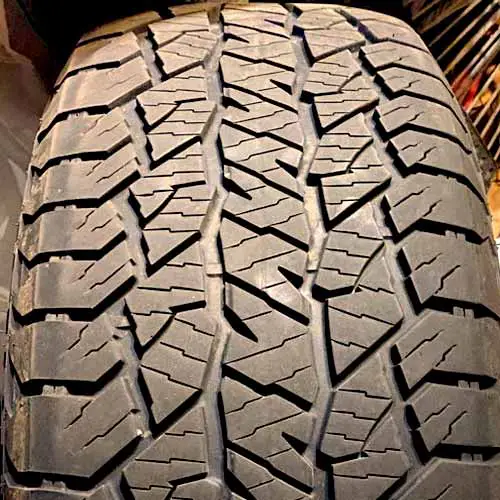Pirelli Scorpion All Terrain Plus and Hankook Dynapro AT2 are both very dependable models for all-terrain tires. Both these manufacturers offer a very highway oriented pattern offering speed ratings up to H.

Being a tire engineer, my takeaway is that the Hankook Dynapro AT2 although offers a superior traction on dry asphalts with shorter braking distances and handling times, the tire could use some wet traction as it’s rigid compound does not offer better flexibility to siping. The Pirelli Scorpion All Terrain Plus on the other hand, is a better tire for wet roads. It’s is also a better option for snow performance as well. Off roads, although there’s not much to expect out of them, this tire does slightly better on rocky terrains.
Appearance
Let’s start things off with Pirelli Scorpion All Terrain Plus.

This tire offers a slightly more open design, where its shoulder lugs have bigger gaps in them joining the wider longitudinal grooves.
Though with such wider grooves its weird to note that there are no stone ejectors.
In the middle there are P and S shaped lugs, which is intentional if you got it (they are initials for Pirelli Scorpion).
These lugs have notches and off set edges on all blocks for off road biting.
And in order to keep pavement grip in tact as well, they are equipped with foundational supports which keep these lugs in place during braking and acceleration.
And yes one important thing, the sipes on all lugs may seem interlocking as they are making “4” shaped pattern on the outside, they are not like that all the way.
Meaning, when the tire’s rubber wears off, you get to see that the slits of siping are just left with straight lines.
Hankook Dynapro AT2 on the other hand, offers similar design of sipes all the way. You also get to see a lot more biters on this tire on all ribs.

The tire makes a total of 5 ribs, where the inner most is slightly wider having notches facing sideways.
A secondary continuous layer is running beneath this rib, where all these lugs are attached, so the lateral grooves (which also act as biters), are not full depth.
The surrounding ribs have lugs running in pairs having similar groove notches in them. These although don’t have traction notches, their off-set edges yields enough chewing power.
Moving towards shoulder lugs, they also have offset edges but less aggressive siping design compared to central lugs.
That’s because they are optimized for maximum highway grip, that’s why all lugs are joined with each other, enhancing lateral stability and steering communication.
That’s why you get to see the following specs of it’s sizes (having great speed ratings).
Sizes Info
The Hankook Dynapro AT2 has total of 90 sizes which come in 15″ to 22″.
- These sizes have speed ratings of S, T and some even have H.
- Available load ratings are: SL, XL, C, D, E and F.
- And ranging weight: 27 to 80 lbs.
- Tread Depth ranges form 12/32″ to 16.5/32″.
- And all sizes get to have 60k miles warranty.
On the other side, the Pirelli Scorpion AT Plus has limited 22 sizes (16 to 20 inches).
- They come with load ratings of SL, XL, C, D and E.
- Weight range: 29 to 60 lbs.
- Speed ratings of R, S, T, and H.
- Tread depth stays in 13, 15 and maximum 15.5/32″.
- And all sizes have 50k miles warranty.
Dry Performance
The dry performance of all-terrain tires can be evaluated under two different categories. The first one is dry traction which is not a problem with all-terrain tires as they have such high number of biters.
Though the second one, handling and steering communication can get slightly tricky.
Let’s see where these tires sit.
Directional Grip
Grip of the tire depends on the tires contact patch it makes with the surface, so the more the better.
The Hankook Dynapro AT2 offers wider central ribs with traction notches facing in both directions, moreover, all it’s blocks have secondary layer underneath and it acts as foundational supports adding strength to braking and speeding traction.
On the other hand, the Pirelli Scorpion AT plus lacks with it’s voided design and softer rubber of tread, which although has supporting rides, providing braking stability, the grip is not the same in comparison.
Sideways Grip
With aggressive sidewall and shoulder lugs, all-terrain tires do good off-road as they provide bigger groove mouth, they lack in lateral grip, simply because of un-optmized rubber tread (for pavements).
That’s why again the Hankook Dynapro AT2 with closed up lugs over there provide better lateral frictional support adding more to G forces you face while turning the tires.
Handling Stability
Mostly off road tires are heavier as they are built with cut resistant rubber on top (having a thicker layer), and more number of cap plies in their internal construction.
With more weight the tire tends to lag on corners, or in other words, it’s not that responsive to steering inputs.
So it’s not surprising to see that the Dynapro AT2 is not doing so great with it’s one extra layer of polyester casing yielding more average weight (in comparison), though it’s tread with minimal features still keep things under control by providing a nice under and over cornering balance.
Winter Performance
Mostly off road tires coming in now have 3 peak mountain snowflake ratings, which tells us that the tire is at least 10% better than the average all season tire.
Both tires are rated with that so they are not going to disappoint, yet they are different in different areas of snow. Like on snowy roads, the Pirelli Scorpion All Terrain Plus is a better with acceleration and handling.
Whereas the Hankook Dynapro does better with ice with it’s multiple biters in all directions.
Noise and Comfort
The tread of the tire including all features, grooves, sipes, have air in them and as the tire moves, that air pumps out and tires to come back in, this produces noise. Moreover, this air also hits the surface of the tread and this generates more noise.
So it makes sense why Hankook AT2 offers better results in this section. It’s shoulder lugs are pretty closed up together which don’t allow a lot of noise to come in.
Pirelli is not so great here, and being a Italian brand, it’s expected. Though it offers variable pitching and has made significant improvements over it’s previous model (Scorpion ATR).
But being a softer tire is does provide better bump absorption, as it’s more able to spring the roughness of the road with it’s high silica destiny.
For Your Info: In the category of all-terrain tires, Yokohama G015 offers amazing comfort values.
Fuel Efficiency
Tires use fuel as they need energy to roll, and few things like the tire’s weight and tread structure make it hard for the tire to move, and as a result more fuel is required.
With 3 ply polyester casing the Hankook AT2 gets to have more weight in comparison (weighing almost 10 lbs more on the largest size).
So with that it generates greater frictional forces consuming more fuel in return.
Pirelli AT Plus on the other side, is not only better, its one of the top tires in this area, where it’s elastic rubber composition does not produce a lot of rolling resistance. (You can check out the top A/T tire for fuel here).
Tread Life
Tread wear is really influenced by the tire’s composition and construction. The more the weight and softer the rubber, the more the rolling resistance and hence wear.
But that’s not all.
Even though the Hankook Dynapro AT2 has larger weight putting more rubbing on it’s lugs, it’s stiffer compound combined with deeper tread voids, still offer better overall mileage in comparison.
Durability
Durability of all-terrain tires is judged by how they are built. So, the most thing to consider is their internal construction.
In case of Pirelli Scorpion All Terrain Plus, it comes with 2 ply polyester casing which covers the sidewalls from underneath, 2 steel belts and 2 layers of nylon covering on top.
On the other hand, the Hankook Dynapro AT2 provides you with a stronger design, as it comes with 3 ply polyester casing where on top similar layers sit like it’s competitors, providing this tire with better puncture resistance.
Though the Scorpion as slightly thicker lugs which helps with piercing with a little margin.
Wet Performance
Wet performance is sub-categorized in to grip and hydroplaning, and although there are other factors as well, these play a more significant part in determining the overall wet abilities of the tire.
Let’s see what both areas have to offer.
Grip on Wet
Gripping on wet asphalts is a very different scenario, that’s because here most of the grip comes from the tread features of the tire, which includes sipes (as the most significant).
So the total number of sipes and how sipes are designed tell how well a tire is capable to wipe off water from its tread.
The Pirelli Scorpion AT plus does not offer good enough siping, as they are not interlocking.
Such siping pattern basically stay flexible when a tire drives around curves and brakes abruptly.
Nonetheless, with overall softer rubber layers, the sipes aren’t too hard, well, not as hard as the Hankook Dynapro AT2.
Dynapro on the other hand, basically offers better siping but it’s rubber is made very rigid (for tread noise and wear reasons).
Hydroplaning
Hydroplaning resistance is the tire’s ability to clear water off from its grooves swiftly, so it would not float on it, that’s why float speeds determine the tire’s resistance to hydroplaning/aquaplaning.
For Your Info: Float speed is just the maximum speed with which the tire can run on standing water without losing floating and losing traction.
Traction Off-Road
When it comes to rougher tracks, there are a lot of key variables to consider.
And these variable comes with different terrains, so I am going to consider all of them one by one.
Gravely Roads
Stone ejectors are the main ones on gravel sure, but there are other factors involved as well, which mostly include the tire’s weight and the make-up of the tread.
The more the tire weighs, the more the stones are forced to get trapped in the grooves.
Similarly the flexible the tread is, the easier are stone allowed to leave out.
Manufactures have to find a middle ground here, as they can’t make a tread too flexible otherwise it would wear off, similarly by making it too hard, the sharp stone would beco0me difficult to leave.
But still, compared to Pirelli All Terrain Plus, Hankook Dynapro is harder and heavier, so it gets to have more stones sticking in it’s tread.
Furthermore, with compacted shoulder voids, it’s cleaning ability is also compromised, and that’s not an issue with Pirelli, as it offers open gaps there and with it’s groove cones (which act as stone ejectors), supply better overall traction.
Rock Traction
Rocky terrains have a lot of stuff going on, so here, I am just talking about climbing rocks.
It’s a myth that all terrain tires can not perform on rocks, where rocks are not too different form tarmacs, as here you need footprint to grip in.
You also need powerful sidewalls, both form inside and out.
All these features are provided by Hankook Dynapro AT2. It’s 3 ply sides gives you the confidence needed to crawl on rougher tracks, while its lugs over there provide extra footprint with lowered air pressure.
Moreover, comparatively, it also presents you with more no of biting edges.
Pirelli Scorpion All Terrain Plus on the other side does okay, but it’s not that impressive in comparison, it’s 2 ply sidewalls make you worry, and it’s less biters don’t grip as well.
Though with lowered pressure, it’s sidewall lugs offer a very decent lateral aid which is almost on par with Dynapro.
Muddy Tracks
Mud traction depends on mud evacuation capability of the tire. So it’s a big no for packed up tread blocks.
But even though Hankook and Pirelli A/Ts are slightly closed up, they can perform on lighter terrains, and even out of them, the Scorpion A/T plus does better as it offers sideways mud evacuation.
Hankook Dynapro has longitudinal channels with closed up lateral voids, so escaping of thick mud there is a little difficult.
Moreover, this tire also lacks by not providing staggered shoulders which act as mud scoops to form forward momentum.
Performance on Sand
On sand, the tire is good with lighter terrains, as it focuses on forward momentum instead of digging with it’s smooth lugs.
The Hankook Dynapro AT2 is a better pick here, as its smooth sides don’t dig in too much and it’s sidewall lugs can used with lowered air pressure which can provide ample tread print.
Pirelli Scorpion on the other hand, does better on less deeper sandy terrains, especially on hills where it can climb better with it’s lighter weight.
Take Home Points
Both all terrain tires are very nice, no doubt, but you cant have a tire better in all sections. That’s why Pirelli Scorpion All Terrain Plus is better with fuel economy, wet traction, and some snowy and off road terrains.
Hankook Dynapro AT2 on the other hand, offers superior durability and rock climbing, sand performance and impresses on road with it’s tread wear resistance, noise reducing tread and overall grip on dry roads.